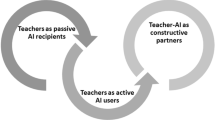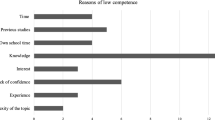Abstract
Teachers are not typically involved as participatory designers in the design of technology-enhanced learning environments. As they have unique and valuable perspectives on the role of technology in education, it is of utmost importance to engage them in a participatory design process. Adopting a case study methodology, we aim to reveal in what ways teachers work as participatory designers and define conditions that support teachers in that. Two initiatives of participatory design in Canada and Singapore were investigated. Design materials, transcripts of design meetings, and interviews with teachers were qualitatively analyzed. Case study 1 (Canada) showed that two teachers participating in software design for an astronomy curriculum contributed by suggesting new design features, introducing pedagogical requirements, and providing feedback on prototypes or design ideas. It appeared essential that teachers feel that their ideas were valued and respected in the entire process. In case study 2 (Singapore), six teachers contributed to the design of a mobile learning trail through: Theorizing and bridging knowledge building principles, collaborative prototyping, contextual inquiry of activity relevance and activity execution, and collaborative evaluation of technology integration. Teachers valued case study discussions with similar cultural contexts and visiting the learning site to design with contextual knowledge. From our case studies, it can be concluded that teachers contribute to the design processes by engaging in theoretical discussion, active participation in a design partnership, reflection about pedagogy and practice, and experimenting with enactment. Conditions that support teachers include support in emergent processes and an atmosphere of trust and inclusion.





Similar content being viewed by others
References
Barab, S. (2004). Using design to advance learning theory, or using learning theory to advance design. Educational Technology, 44(3), 16–20.
Barab, S. (2006). Design-based research: A methodological toolkit. In R. K. Sawyer (Ed.), The Cambridge handbook of the learning sciences (pp. 153–170). New York: Cambridge University Press.
Barab, S., Zuiker, S., Warren, S., Hickey, D., Ingram-Goble, A., Kwon, E. J., et al. (2007). Situationally embodied curriculum: Relating formalisms and contexts. Science Education, 91(5), 750–782. doi:10.1002/sce.20217.
Bødker, S., & Iversen, O. S. (2002, October). Staging a professional participatory design practice: Moving PD beyond the initial fascination of user involvement. In Proceedings of the second Nordic conference on human–computer interaction (pp. 11–18). New York: ACM. doi:10.1145/572020.572023.
Brandt, E. (2006). Designing exploratory design games: A framework for participation in participatory design? In Proceedings of the ninth conference on participatory design: Expanding boundaries in design (Vol. 1, pp. 57–66). New York: ACM. doi:10.1145/1147261.1147271.
Brown, A. L. (1992). Design experiments: Theoretical and methodological challenges in creating complex interventions in classroom settings. The Journal of the Learning Sciences, 2(2), 141–178. doi:10.1207/s15327809jls0202_2.
Brown, M. W. (2011). The teacher–tool relationship: Theorizing the design and use of curriculum materials. In J. T. Remillard, B. A. Herbel-Eisenmann, & G. M. Lloyd (Eds.), Mathematics teachers at work: Connecting curriculum materials and classroom instruction (pp. 17–37). New York: Routledge.
Carlgren, I. (1999). Professionalism and teachers as designers. Journal of Curriculum Studies, 31(1), 43–56. doi:10.1080/002202799183287.
Chan, C. K. K. (2008). Pedagogical transformation and knowledge-building for the Chinese learner. Evaluation and Research in Education, 21(3), 235–251. doi:10.1080/09500790802485245.
Chen, Y. S., Kao, T. C., & Sheu, J. P. (2003). A mobile learning system for scaffolding bird watching learning. Journal of Computer Assisted learning, 19(3), 347–359. doi:10.1046/j.0266-4909.2003.00036.x.
Cobb, P., Confrey, P., diSessa, A., Lehrer, R., & Schauble, L. (2003). Design experiments in educational research. Educational Researcher, 32(1), 9–13. doi:10.3102/0013189X032001009.
Cober, R., McCann, C., Moher, T., & Slotta, J. D. (2013, June). Aggregating students’ observation in support of community knowledge and discourse. In Proceedings of the 10th international conference on Computer-supported collaborative learning (CSCL) (pp. 121–128). New Brunswick: International Society of the Learning Sciences.
Creswell, J. W. (2013). Qualitative inquiry and research design: Choosing among five approaches. New York: Sage.
Druin, A. (2002). The role of children in the design of new technology. Behaviour and Information Technology, 21(1), 1–25. doi:10.1080/01449290110108659.
Eliasson, J., Pargman, T. C., Nouri, J., Spikol, D., & Ramberg, R. (2011). Mobile devices as support rather than distraction for mobile learners: Evaluating guidelines for design. International Journal of Mobile and Blended Learning, 3(2), 1–15. doi:10.4018/jmbl.2011040101.
Hewitt, J., & Scardamalia, M. (1998). Design principles for distributed knowledge building processes. Educational Psychology Review, 10(1), 75–96.
Kensing, F., & Blomberg, J. (1998). Participatory design: Issues and concerns. Computer Supported Cooperative Work, 7(3–4), 167–185.
Könings, K. D., Brand-Gruwel, S., & van Merriënboer, J. J. G. (2011). Participatory instructional redesign by students and teachers in secondary education: Effects on perceptions of instruction. Instructional Science, 39, 737–762. doi:10.1007/s11251-010-9152-3.
Lingnau, A., Harrer, A., Kuhn, M., & Hoppe, U. (2007). Empowering teachers to evolve media enriched classroom scenarios. Research and Practice in Technology Enhanced Learning, 2(2), 105–129.
Lingnau, A., Hoppe, H. U., & Mannhaupt, G. (2003). Computer supported collaborative writing in an early learning classroom. Journal of Computer Assisted learning, 19(2), 186–194. doi:10.1046/j.0266-4909.2003.00019.x.
Matuk, C., & Linn, M. C. (2015). Technology to support teachers using evidence from student work to customize technology-enhanced inquiry units. Instructional Science. doi:10.1007/s11251-014-9338-1.
McKenney, S., Kali, Y., Markauskaite, L., & Voogt, J. (2015). Teacher design knowledge for technology enhanced learning: A framework for investigating assets and needs. Instructional Science. doi:10.1007/s11251-014-9337-2.
Moher, T. (2006, April). Embedded phenomena: Supporting science learning with classroom-sized distributed simulations. In Proceedings of the SIGCHI conference on human factors in computing systems (pp. 691–700). New York: ACM. doi:10.1145/1124772.1124875.
Muller, M. J., & Kuhn, S. (1993). Special issue on participatory design. Communications of the ACM, 36(6), 24–28.
Oshima, J., Oshima, R., Murayama, I., Inagaki, S., Takenaka, M., Yamamoto, T., et al. (2006). Knowledge-building activity structures in Japanese elementary science pedagogy. International Journal of Computer-Supported Collaborative Learning, 2(1), 229–246. doi:10.1007/s11412-006-8995-8.
Penuel, W. R., & Gallagher, L. P. (2009). Preparing teachers to design instruction for deep understanding in middle school Earth science. The Journal of the Learning Sciences, 18(4), 461–508. doi:10.1080/10508400903191904.
Penuel, W., Roschelle, J., & Shechtman, N. (2007). Designing formative assessment software with teachers: An analysis of the co-design process. Research and Practice in Technology Enhanced Learning, 2(1), 51–74.
Penuel, W. R., Fishman, B. J., Cheng, B. H., & Sabelli, N. (2011). Organizing research and development at the intersection of learning, implementation, and design. Educational Researcher, 40(7), 331–337.
Peters, V. L., & Slotta, J. D. (2008). Co-designing a knowledge building activity with secondary school biology teachers. Retrieved from http://www.ikit.org. Accessed 31 March 2014.
Peters, V. L., & Slotta, J. D. (2009). Co-designing curricula to promote collaborative knowledge construction in secondary school science. In Proceedings of the 9th international conference on Computer-supported collaborative learning (pp. 204–213). New Brunswick: International Society of the Learning Sciences.
Reiser, B. J., Spillane, J. P., Steinmuller, F., Sorsa, D., Carney, K., & Kyza, E. (2000). Investigating the mutual adaptation process in teachers’ design of technology-infused curricula. In B. Fishman & S. O’Connor-Divelbiss (Eds.), Fourth international conference of the learning sciences (pp. 342–349). Mahwah, NJ: Erlbaum.
Rogers, Y., & Price, S. (2008). The role of mobile devices in facilitating collaborative inquiry in situ. Research and Practice in Technology Enhanced Learning, 3(3), 209–229.
Roschelle, J., Penuel, W. R., & Shechtman, N. (2006). Co-design of innovations with teachers: Definition and dynamics. In Proceedings of the international conference of the learning sciences (pp. 606–612). New Brunswick: International Society of the Learning Sciences.
Sawyer, R. K. (2004). Creative teaching: Collaborative discussion as disciplined improvisation. Educational Researcher, 33(2), 12–20.
Sawyer, R. K. (2011). What makes good teachers great? The artful balance of structure and improvisation. In R. K. Sawyer (Ed.), Structure and improvisation in creative teaching (pp. 1–24). New York: Cambridge University Press.
Scardamalia, M., & Bereiter, C. (2003). Knowledge building. In J. W. Guthrie (Ed.), Encyclopedia of education (pp. 1370–1373). New York: Mcmillan Reference.
Scardamalia, M., & Beretier, C. (2006). Knowledge building: Theory, pedagogy, and technology. In R. K. Sawyer (Ed.), The Cambridge handbook of the learning sciences (pp. 107–123). New York: Cambridge University Press.
Schuler, D., & Namioka, A. (Eds.). (1993). Participatory design: Principles and practices. Hillsdale, NJ: Lawrence Erlbaum Associates Inc.
Sharples, M., Taylor, J., & Vavoula, G. (2007). A theory of learning for the mobile age. In R. Andrews & C. Haythornthwaite (Eds.), The Sage handbook of e-learning research (pp. 221–247). London: Sage.
Shrader, G., Williams, K., Lachance-Whitcomb, J., Finn, L. E., & Gomez, L. (2001, April). Participatory design of science curricula: The case for research for practice. Paper presented at the Annual Meeting of the American Educational Research Association, Seattle, WA. Retrieved from http://www.letus.org/PDF/ShradervaeraSpencer.pdf. Accessed 7 July, 2014.
Spikol, D., Milrad, M., Maldonado, H., & Pea, R. (2009, July). Integrating co-design practices into the development of mobile science collaboratories. In Ninth IEEE international conference on advanced learning technologies (pp. 393–397). IEEE. doi:10.1109/ICALT.2009.175.
Squire, K., & Klopfer, E. (2007). Augmented reality simulations on handheld computers. The Journal of the Learning Sciences, 16(3), 371–413. doi:10.1080/10508400701413435.
Suchman, L. (1993). Forward. In D. Schuler & A. Namioka (Eds.), Participatory design: Principles and practices (pp. vii–ix). Hillsdale, NJ: Lawrence Erlbaum Associates Inc.
Svihla, V., Reeve, R., Sagy, O., & Kali, Y. (2015). A fingerprint pattern of supports for teachers’ designing of technology-enhanced learning. Instructional Science. doi:10.1007/s11251-014-9342-5.
Toronto District School Board. (2007). Toronto District School Board ICT Standards: Digital learning for kindergarten to grade 12. Resource document retrieved from http://www.tdsb.on.ca/wwwdocuments/programs/computers_in_schools/docs/TDSB-ICT_Standards_Bookmarked.pdf. Accessed 31 March, 2014.
Vavoula, G., & Sharples, M. (2007). Future technology workshop: A collaborative method for the design of new learning technologies and activities. International Journal of Computer-Supported Collaborative Learning, 2(4), 393–419.
Voogt, J., Laferrière, T., Breuleux, A., Itow, R., Hickey, D., & McKenney, S. (2015). Collaborative design as a form of professional development. Instructional Science. doi:10.1007/s11251-014-9340-7.
Yin, R. K. (2009). Case study research: Design and methods. Thousand Oaks, CA: Sage.
Yoon, S. A., Liu, L., & Goh, S. E. (2009, June). Exploring the process of convergent adaptation in technology-based science curriculum construction. In Proceedings of the 9th international conference on computer-supported collaborative learning (pp. 272–281). New Brunswick: International Society of the Learning Sciences.
Zhang, B., Looi, C. K., Seow, P., Chia, G., Wong, L. H., Chen, W., et al. (2010). Deconstructing and reconstructing: Transforming primary science learning via a mobilized curriculum. Computers & Education, 55(4), 1504–1523. doi:10.1016/j.compedu.2010.06.016.
Acknowledgments
The first and third authors would like to acknowledge the generous participation of teachers and administrators from the Dr. Eric Jackman Institute of Child Study. We thank all members of the Encore Lab who contributed to the design effort, including researchers and developers. We also gratefully acknowledge funding from Canadian Social Sciences and Humanities Research Council and from the U.S. National Science Foundation. The Future School project at the School of Science and Technology (SST) is part of the FutureSchools@Singapore project and is supported by the National Research Foundation’s (NRF) Interactive and Digital Media (IDM) in Education Research and Development (R&D) Programme, Singapore. The research study was conducted when the second and fourth authors were at the National Institute of Education, Nanyang Technological University. All authors thank the collaborating teachers and students, and all software engineers and researchers for their contribution to this research.
Author information
Authors and Affiliations
Corresponding author
Rights and permissions
About this article
Cite this article
Cober, R., Tan, E., Slotta, J. et al. Teachers as participatory designers: two case studies with technology-enhanced learning environments. Instr Sci 43, 203–228 (2015). https://doi.org/10.1007/s11251-014-9339-0
Received:
Accepted:
Published:
Issue Date:
DOI: https://doi.org/10.1007/s11251-014-9339-0




